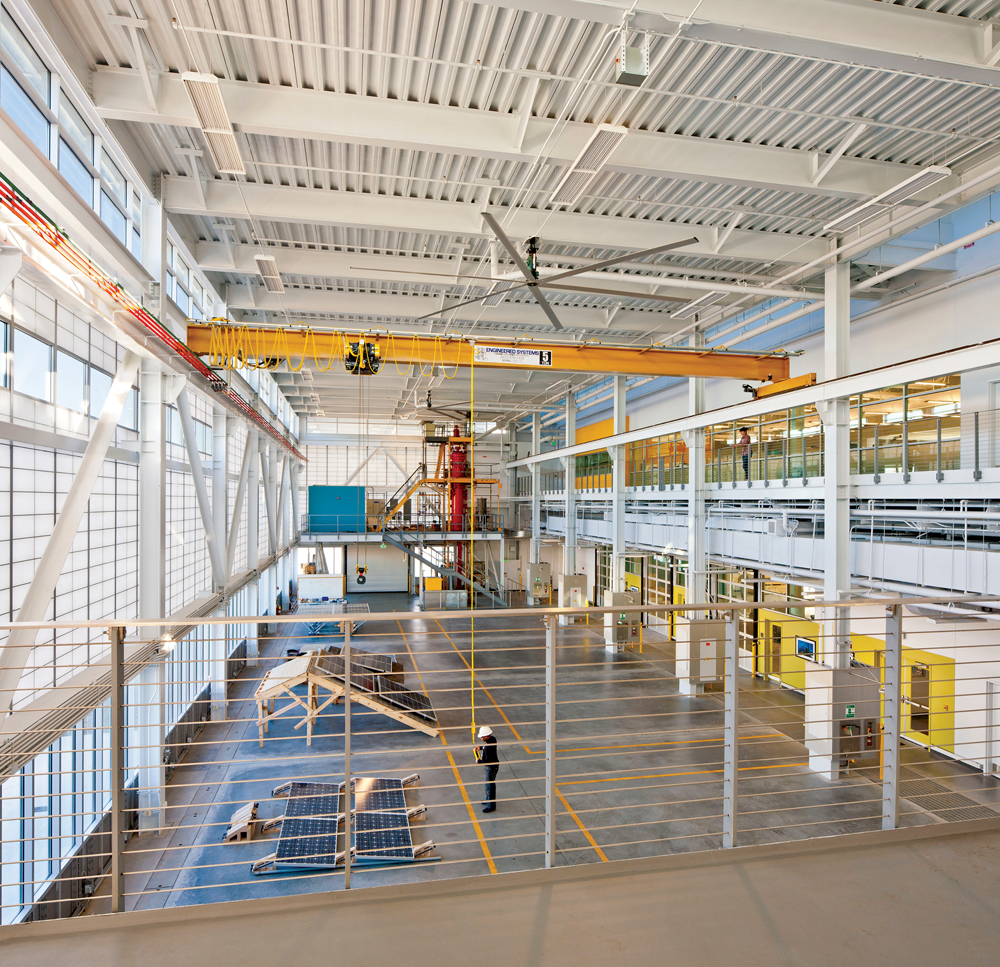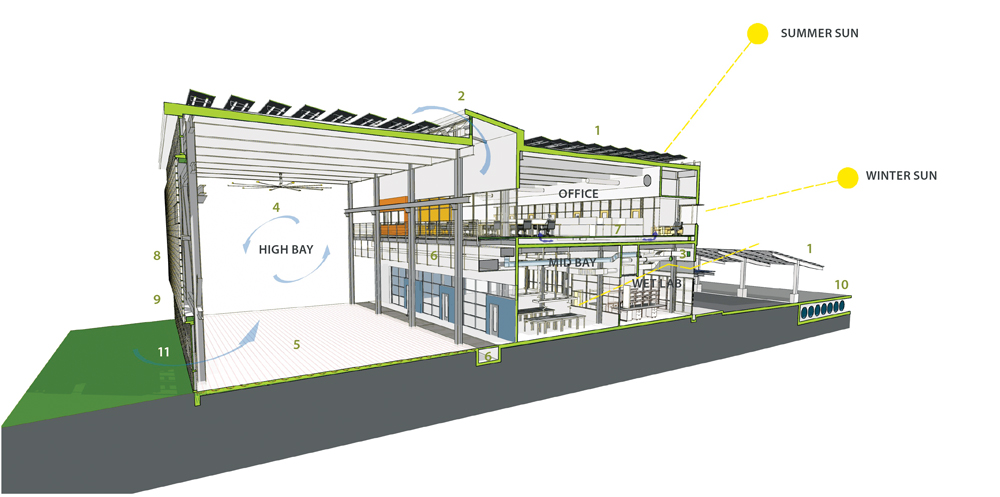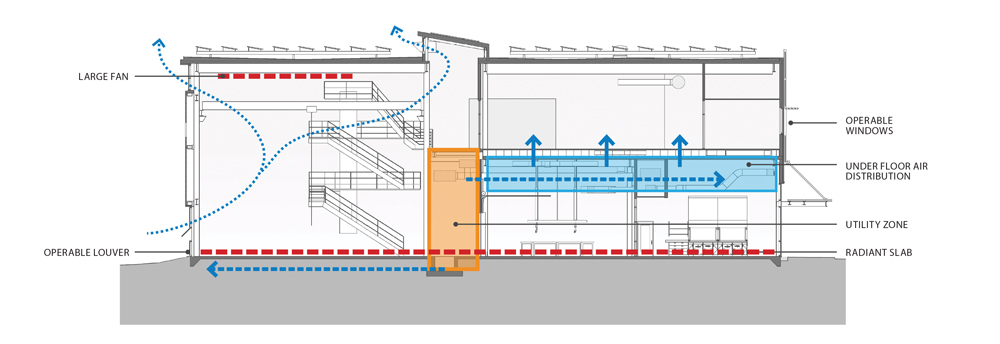Georgia Tech always intended its new energy science facility to be a sustainable building. The project was envisioned as a living lab, embodying the high performance goals that would be explored by the researchers inside. The school needed an adaptable space to accommodate unknown users, scientific techniques, and equipment. A fairly simple high-bay box was the initial plan.
Midway through schematic design, the client heard about a promising construction-grant competition being run by the National Institute of Standards and Technology. Tech halted its project and applied for a grant with the active assistance of its design-build team, including
architect/engineer HDR Inc. and construction manager Gilbane Building Co. The process delayed the job by a year but eventually added $11.6 million to the budget, allowing the school to shoot for a net-zero facility worthy of the name “Carbon-Neutral Energy Solutions Laboratory.”
NIST’s stipulations required the team to adopt a more fast-track, “IPD-light” approach, but also encouraged a more ambitious design. Because all significant team members had been hired early, relationships were already well-established, making a freewheeling exchange of ideas more fruitful.
The shop-like, flexible high-bay lab space accommodates industrial-scale fabrication experiments. Accessible utility trenches in the slab allow unobstructed operation of the industrial crane.
“The original thought was that this would be a low-tech building done fairly quickly, flexibly, and inexpensively,” says HDR Design Principal Dan Rew, AIA. “But when the project became more ambitious, Georgia Tech became the driver for an attempt at net-zero. The campus already had a lot of sustainable projects, which helped. Our discussions with Gilbane about constructability, and their previous efforts at creating energy-efficient buildings, including some net- zero projects they were already working on, also helped.”
In addition, Georgia Tech’s Director of Capital Planning and Space Management, Howard S. Wertheimer, FAIA, LEED AP, was an unusually well-informed and imaginative decision maker. In previous work as a private-sector architect, Wertheimer had designed many complex science buildings himself.
“We already had several science buildings on campus, and because I personally had done many others around the country, there was already a high level of understanding about what this project needed to be,” he says. “This project offered a good opportunity to push the upper limit, and Dan and [Gilbane’s project manager] Paul Stewart brought us some broader perspectives.” Wertheimer also credits valuable input from Tech’s Planning and Design Commission, consisting of external architects and landscape architects who visit the campus quarterly.
Upgrading the plan to achieve more versatile performance
Eventually the team agreed that the project would benefit from a revised program, not just more sophisticated sustainability tactics. Three space typologies were developed: the original high-bay “box” for industrial-scale work; mid-bay labs for science requiring smaller equipment but more stringent environmental control; and office-like computational labs, stacked above the mid-bay labs. This versatility would allow the school to tackle a wide range of projects, including work in combustion, gasification, biochemical-enzymatic conversion of biomass, and CO2 capture.
The Building Team developed specs for temperatures, humidity levels, and ventilation for each lab type, favoring passive design where possible. Under-floor air distribution and radiant slab heating proved useful, and the 9,000-sf high-bay space is not air-conditioned—a bold move in Atlanta.
Features that helped the facility achieve net-zero design and LEED Platinum certification: 1) PV arrays; 2) clerestory windows; 3) light louvers; 4) ceiling fan; 5) radiant slab heating; 6) a shared utility zone; 7) under-floor air distribution; 8) translucent Kalwall cladding; 9) operable windows; 10) permeable concrete; and 11) operable louvers.
“We were willing to take some risks,” says Wertheimer. “If in the future the space becomes too uncomfortable, we have made provisions so we can add air conditioning. But in general, we were willing to take some internal risks to explore new ideas.”
The building’s initial energy baseline was modeled at 147 kBtu/sf/year: drastically less than the 200 to 400 kBtu typical for research labs. Passive design and selected energy-efficiency strategies ultimately reduced that number to 70 kBtu/sf/year. Crucial to making the numbers work: crystalline PV panels installed on the roof, a south-facing wall, and a parking canopy, with an anticipated electrical output of 388,000 kWh/year. This contribution represents 56% of the building’s expected electrical demand, and 26% of the overall baseline energy demand.
Team strategies that helped produce a successful project included:
• BIM. The client’s highest ever Level of Development with BIM, LOD 500, was selected. The model was used not only to guide design but also for project management, clash detection, and shop drawing review and preconstruction meetings. Georgia Tech took advantage of the Building Team’s expertise to develop a campuswide BIM execution plan during the project.
• Interactive scheduling. Gilbane and its subcontractors met weekly in a field office for updates, benefitting from implementation of a 4-D Navisworks scheduling platform and regular use of a three-week “look ahead” schedule and milestones.
• Energy modeling. Various mechanical system options were rigorously analyzed for life cycle cost ramifications. For instance, the Building Team compared a high-efficiency, magnetic-bearing chiller with a ground-source heat exchange system. They rejected the ground-source system, which cost $500,000 more, after modeling revealed that it was slightly less energy-efficient. The cost-benefit profiles of forced natural ventilation, an enthalpy wheel, a night setback for HVAC, and daylighting controls all were verified before systems were approved; insulated translucent exterior panels didn’t make the cut.
• Lean principles. Gilbane’s chief estimator came on board early and used real-time cost models as the design progressed, giving HDR continuous feedback. This procedure reduced the need for drastic value engineering during later stages. Says Gilbane’s Stewart, “We were at the HDR office three or four times a week, seeing where the design was going and keeping the pricing on track. That made the ultimate buyout a lot easier. We avoided a slowdown in VE, which is something that can kill a project.”
In the mid-bay labs, transparent garage-type doors allow experiments to be moved in and out. Overhead utility infrastructure keeps floor space and lab benches unencumbered.
A year after occupancy, the facility is tracking extremely well on its energy-use estimates, says Wertheimer. “Part of that is because we still don’t have really heavy plug loads,” he explains. “We’re not yet fully occupied, so the equipment picture is not complete, but we expect the increase in energy use will be significant. In any event, we’ll be in a much better place than we would have been if we’d created a more conventional building.”
The project has garnered numerous state and national awards, including High Honors in R&D Magazine’s 2013 Laboratory of the Year competition. Team members have made many presentations at professional conferences, helping to ensure that the lessons learned will resonate beyond Atlanta.
Rew concludes, “There are a lot of ideas here that Tech has explored in other places around the campus and pulled together in this project. Not just in energy efficiency, but also in material selection, site use, water retention—just doing the right thing across the board. It’s a LEED Platinum project, but I don’t think Tech was just shooting for a LEED goal. Doing a building like this is a lot more fun than just chasing LEED points.”
Careful planning makes the most of passive ventilation and reduces energy demand. Sustainable strategies are documented and tracked through a “dashboard” display in the lobby, which helps students understand various metrics (energy use, PV generation, ambient air temperature, lighting levels, water consumption).
Project summary
PLATINUM AWARD
Georgia Tech Carbon-Neutral Energy Solutions (CNES) Laboratory
Atlanta
BUILDING TEAM
Submitting firms: Gilbane Building Co. and HDR Inc. (design-build team)
Owner: Georgia Tech
Structural: Ksi/Structural Engineers
MEP/civil: HDR
Energy modeling: EMO Energy Solutions
GENERAL INFORMATION
Project size: 42,000 sf
Construction cost: $22.4 million
Construction time: May 2011 to July 2012
Delivery method: Design-build
Related Stories
| Aug 11, 2010
Residence hall designed specifically for freshman
Hardin Construction Company's Austin, Texas, office is serving as GC for the $50 million freshman housing complex at the University of Houston. Designed by HADP Architecture, Austin, the seven-story, 300,000-sf facility will be located on the university's central campus and have 1,172 beds, residential advisor offices, a social lounge, a computer lab, multipurpose rooms, a fitness center, and a...
| Aug 11, 2010
News Briefs: GBCI begins testing for new LEED professional credentials... Architects rank durability over 'green' in product attributes... ABI falls slightly in April, but shows market improvement
News Briefs: GBCI begins testing for new LEED professional credentials... Architects rank durability over 'green' in product attributes... ABI falls slightly in April, but shows market improvement
| Aug 11, 2010
Luxury Hotel required faceted design
Goettsch Partners, Chicago, designed a new five-star, 214-room hotel for the King Abdullah Financial District (KAFD) in Riyadh, Saudi Arabia. The design-build project, with Saudi Oger Ltd. as contractor and Rayadah Investment Co. as developer, has a three-story podium supporting a 17-story glass tower with a nine-story opening that allows light to penetrate the mass of the building.
| Aug 11, 2010
Three Schools checking into L.A.'s Ambassador Hotel site
Pasadena-based Gonzalez Goodale Architects is designing three new schools for Los Angeles Unified School District's Central Wilshire District. The $400 million campus, located on the site of the former Ambassador Hotel, will house a K-5 elementary school, a middle school, a high school, a shared recreation facility (including soccer field, 25-meter swimming pool, two gymnasiums), and a new publ...
| Aug 11, 2010
New Jersey's high-tech landscaping facility
Designed to enhance the use of science and technology in Bergen County Special Services' landscaping programs, the new single-story facility at the technical school's Paramus campus will have 7,950 sf of classroom space, a 1,000-sf greenhouse (able to replicate different environments, such as rainforest, desert, forest, and tundra), and 5,000 sf of outside landscaping and gardening space.
| Aug 11, 2010
U.S. firm designing massive Taiwan project
MulvannyG2 Architecture is designing one of Taipei, Taiwan's largest urban redevelopment projects. The Bellevue, Wash., firm is working with developer The Global Team Group to create Aquapearl, a mixed-use complex that's part of the Taipei government's "Good Looking Taipei 2010" initiative to spur redevelopment of the city's Songjian District.
| Aug 11, 2010
Florida mixed-use complex includes retail, residential
The $325 million Atlantic Plaza II lifestyle center will be built on 8.5 acres in Delray Beach, Fla. Designed by Vander Ploeg & Associates, Boca Raton, the complex will include six buildings ranging from three to five stories and have 182,000 sf of restaurant and retail space. An additional 106,000 sf of Class A office space and a residential component including 197 apartments, townhouses, ...
| Aug 11, 2010
Restoration gives new life to New Formalism icon
The $30 million upgrade, restoration, and expansion of the Mark Taper Forum in Los Angeles was completed by the team of Rios Clementi Hale Studios (architect), Harley Ellis Devereaux (executive architect/MEP), KPFF (structural engineer), and Taisei Construction (GC). Work on the Welton Becket-designed 1967 complex included an overhaul of the auditorium, lighting, and acoustics.











